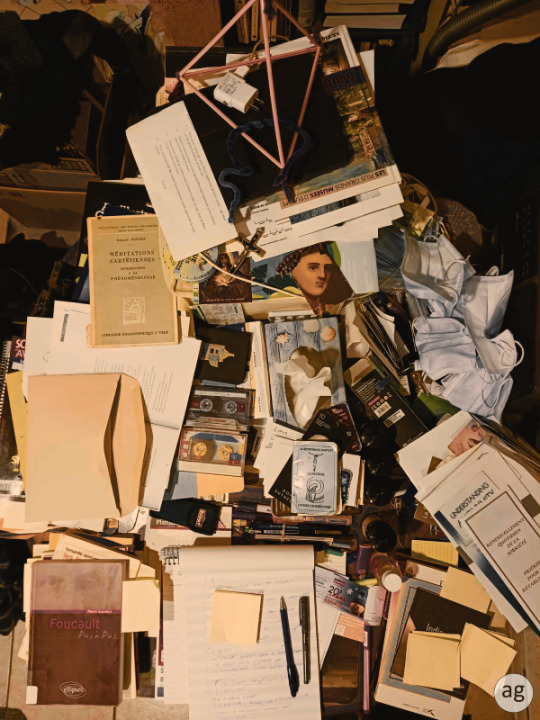Text

THE SWITCHBOARD METHOD OF PROJECT-BASED, SERIAL ART PRODUCTION
"Work Efficiency At The Speed of Thought"
2023-11-29 12:10:08
The Switchboard Method:
Take n number of tasks;
Choose one task at a time, work on it for approximately 15 minutes, then SWITCH TASKS;
Continue doing this continuously throughout the day, switching tasks every 5-10 or 15 minutes;
Switch tasks pseudo-randomly, that is, choose whatever task is most immediate;
Choose whatever tasks is most relevant to the given time;
Choose tasks that are more ready-to-hand either physically proximate or else close to you in your cognitive space, emotional space, your Fields of Experience or Fields of Discourse;
Act as though you were a MECHANICAL TURK at Amazon;
You will achieve more efficiency this way;
Take an example. Say someone writes 1 novel in 1 notebook;
Now you write 12 novels in 12 notebooks, except you use the SWITCHBOARD METHOD;
The other person might finish their 1 novel in x amount of time;
You will finish in x+y amount of time, y being a constant;
It will take you a little more time to write 12 novels across 12 notebooks instead of 1 across 1, but at the end of x+y time, you will have written 12 NOVELS INSTEAD OF 1;
The SWITCHBOARD METHOD is essentially a NON-LINEAR METHOD OF WORK ORGANIZATION and can provide Great Efficiencies in Time (awaiting mathematical proof);
2023-11-29 19:45:22
I am told this is the assignment problem in theoretical computer science, but usually you have n agents to whom you must assign m number of tasks;
In my case, there are only n tasks and 1 agent;
All that's really important here is the decision problem and efficient allocation of resources;
You would normally look at costs and so forth, cost functions, etc.;
Thats not my problem, though; I got rid of the decision problem and saved at least 1 bit;
It might not seem like a lot, yet computationally, with over 100 projects still actively running in my Art Operation, I needed to save as many bits as possible;
I don't decide what task to work on; I tackle whatever is most proximate/immediate/ready-to-hand;
It doesn't matter what it is,it will absolutely be an enriching,learning experience;
Randomized task assignment just seems optimal to me; I'm able to maintain over 100 complex, interdisciplinary art-research projects, and I'm a One-Man Shop, a single art operator at the Art Operation @ The Historiotheque;
More on this later; this is based on the research for a new project, and series of series, I started earlier in the year, called NOISE IN THE WORKSPACE;
The first series was called SPACE NOISE INJECTION and, you see, while the first series is still only beginning, I started the second series of experiments, called RANDOMIZED EXPERIMENTAL PARAMETERS;
After just a few months, I have enough research and experimental data to write a PhD thesis in interruption science;
2023-12-04 03:17:26
One of the ways this Method works is by removing waiting-times;
One does not spend any significant amount of times either Deciding what tasks to tackle OR any significant amount of time building up complex mental abstractions, which software developers often have to do in the course of any given period of Deep Work;
I merely look at the Surface of the Workspace and choose what is most proximate/immediate;
This literally means looking around the Studio Space @ The Historiotheque and choosing whatever is nearest in time and space;
I realize that the 3D Surface of the Workspace is where I get most of my new ideas, from actually working in the Historioteque AND in the Archive;
It's where I came up with the concept of Geogrammar or Geogrammatical Forms, as floating land-masses, as portrayed in my novelistic phenomenology The History-Project as Crackland, the Land of Fissures and as Antiface-Cloud in my sequel The Archives-Project;
The so-called land-masses or fragments are really the exposed surfaces of the Stacks (SEE: The Stacks-Project);
Each of these "Stacks" are built-up over time as sedimentary layers or through a sedimentation process;
I continuously Survey the top-post surfaces of these many Stacks and make mental links or REFCARDS which I file in my Inner Refcards-System, my DATABASE-OF-IMAGES (SEE: Database Arts);
SEE: Images below, of the 3D Workspace as Abstract Cartography (seen from above) and two diagrams of THE SWITCHBOARD METHOD as well as one for The Stacks-Project;
[...]
#historiotheque#artoperations#antique-moderne#concrete realism#workspace#delta-workspace#physical algorithms#material memory#the stacks-project#stacks#book stacks
0 notes